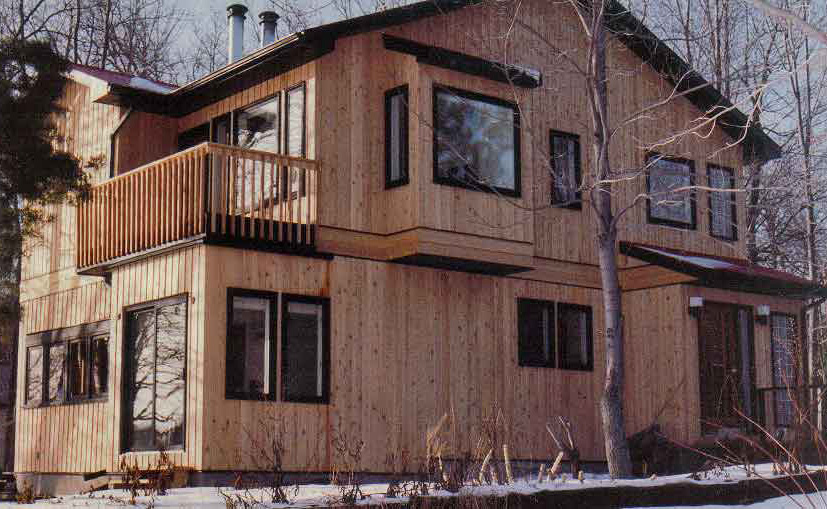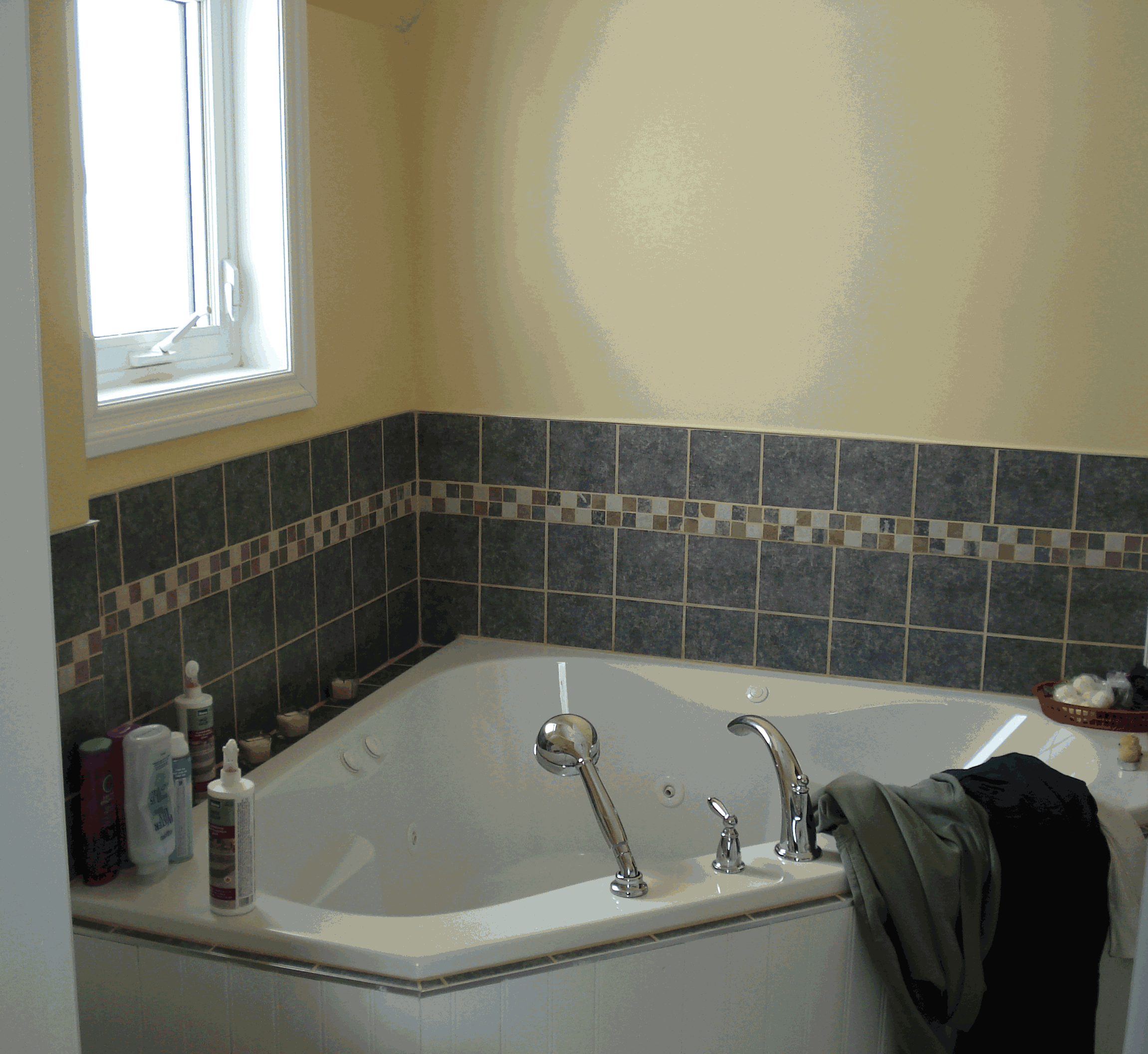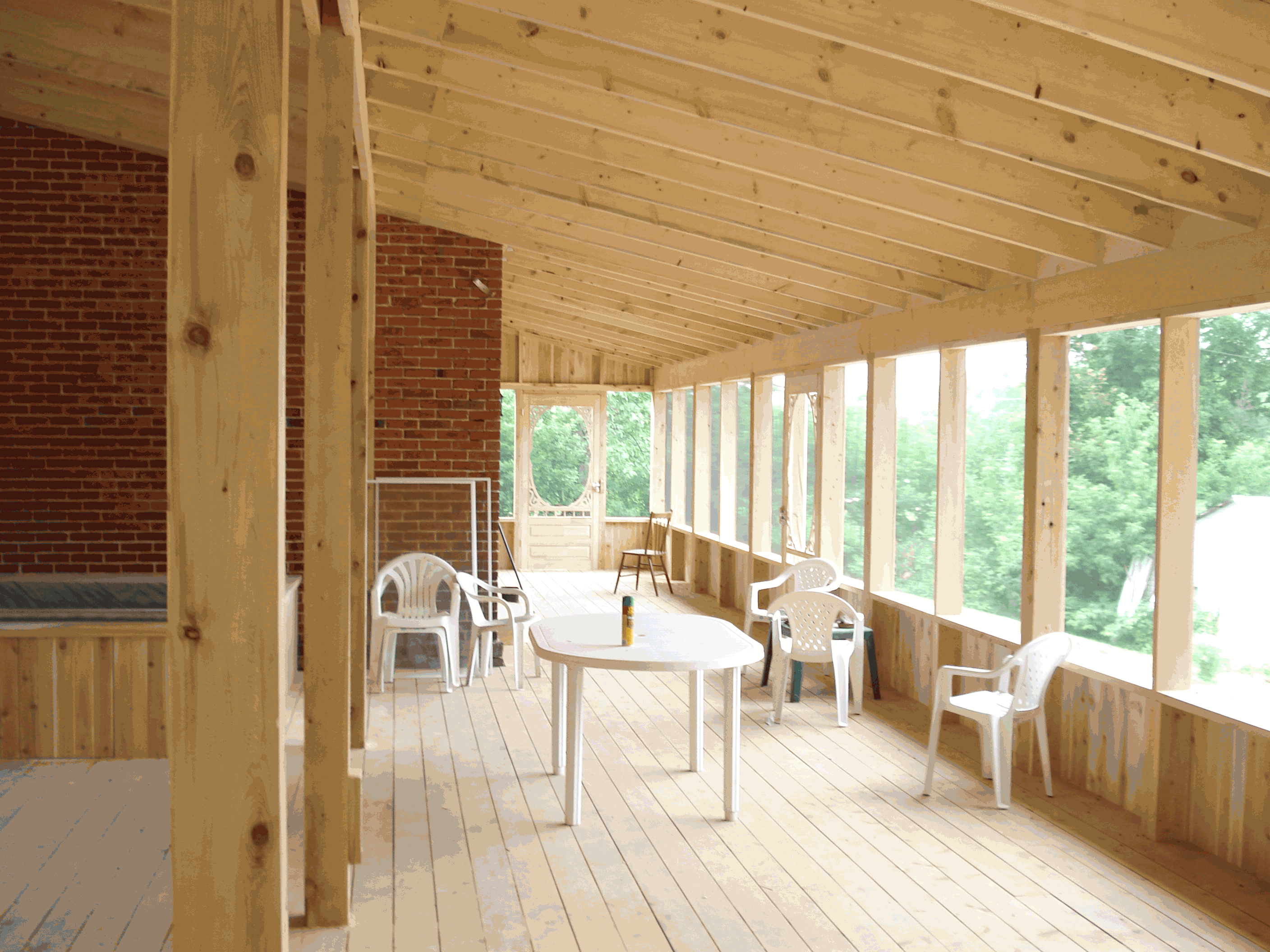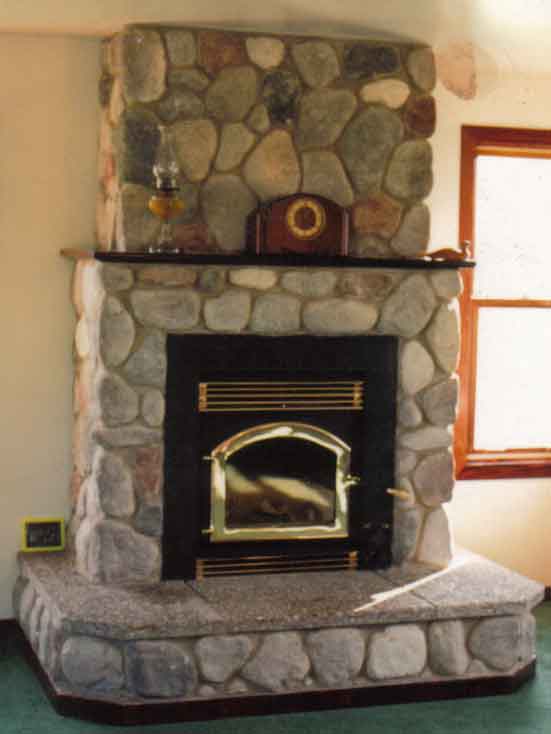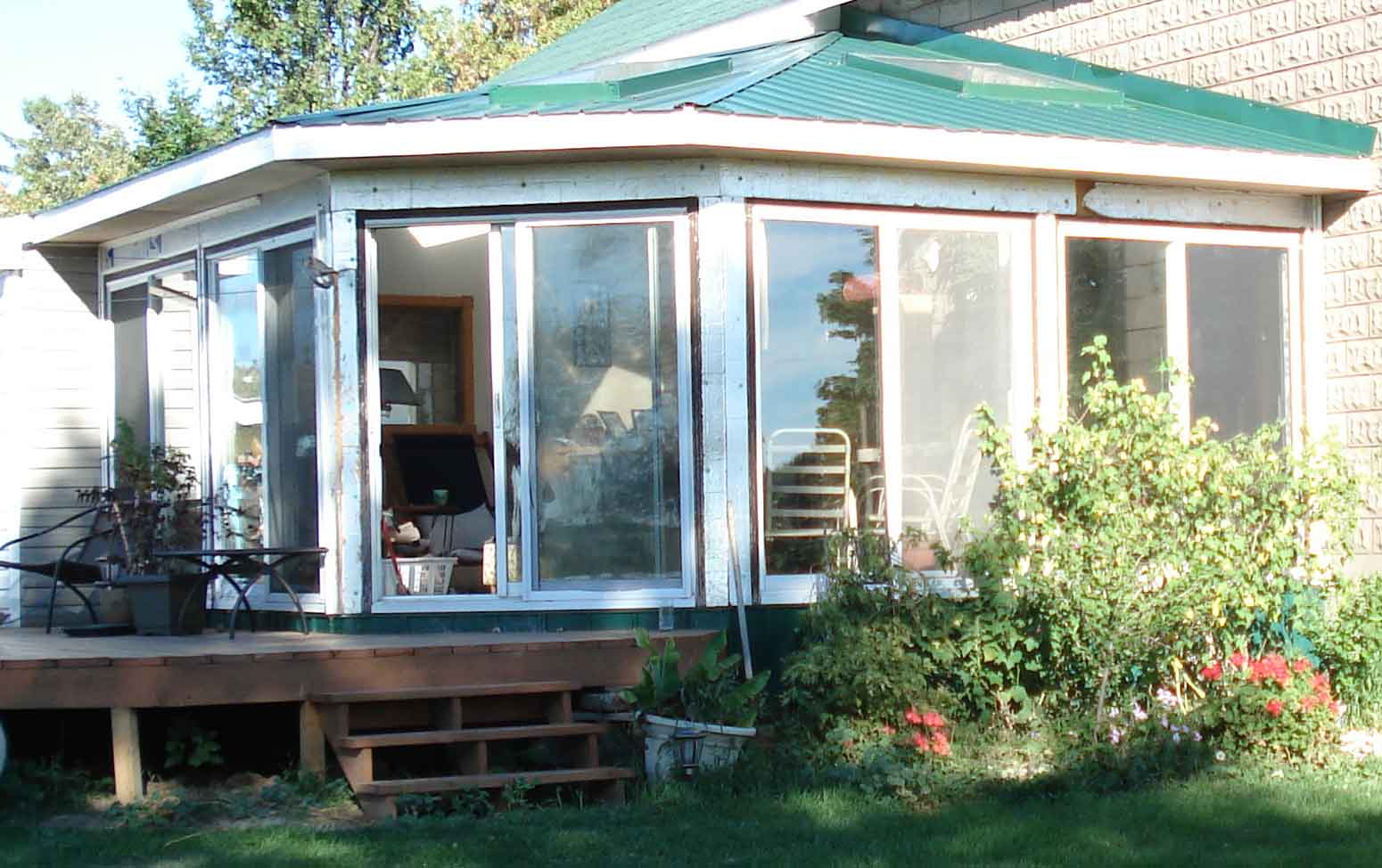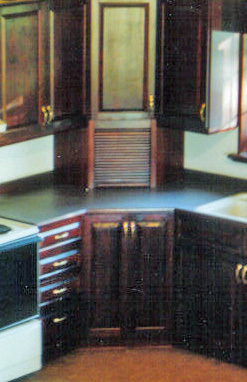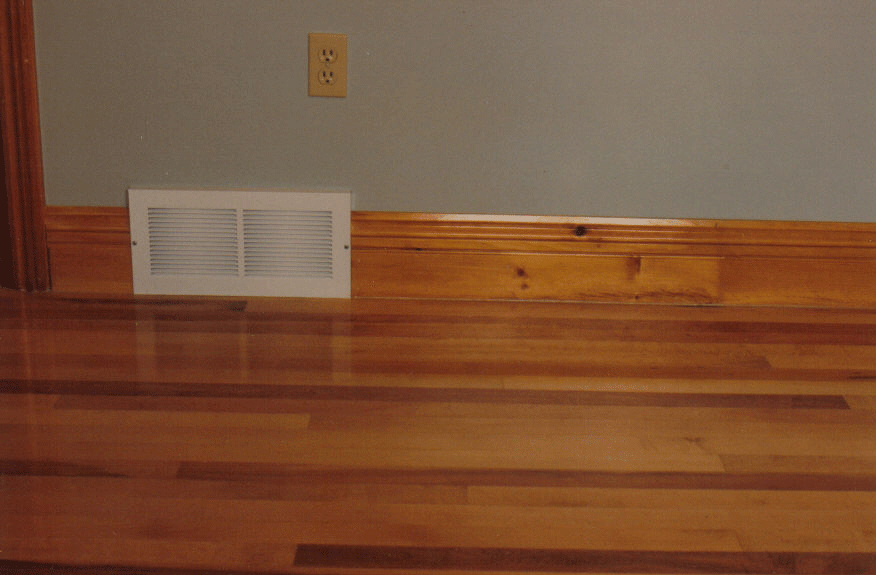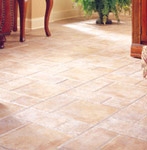Walls, Ceilings, and Floors
| Walls | Ceilings |
Flooring |
Walls and
Ceilings
With the
popularity of
home renovation programs, the choices in wall coverings and ceiling
treatments have never been so varied or so exciting. From the
traditional to the outrageous, forming a focal point or a gracious
backdrop, wall coverings are not only beautiful but functional as
well. Ceilings take on a new function, providing a richness of
texture and colour that commands attention.
Lathe and Plaster
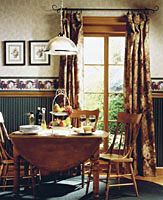
Wainscoting
Fabrics
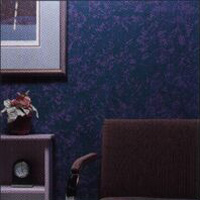


Varnishes
Like paints varnishes come in an array of bases and glosses. The same rule of thumb applies for bases. Use oil based varnishes for high traffic areas or where water is likely to collect. Use water based for low traffic areas and trim.
Varnish glosses differ slightly from paints in that high gloss finishes are more likely to scratch and need to be refinished more often. High gloss is not suitable for high usage or traffic areas such as floors, counter tops, or table tops. To develop a glass like shine in these areas, use semi gloss varnish. Once completely dry, build high gloss shine using 2-3 coats of good quality paste wax (available at hardware stores).
Wallpaper
Metal Tile
Smooth transitions
| Lathe and Plaster | Drywall | Wood
and Paneling |
| Laminates | Fabric | Venetian Plaster |
| Paint |
Wall Paper |
Glass Block |
| Tile |
Metal
Tiles |
Built-in
Units |
Lathe and Plaster
Once
considered the
only choice in smooth low-maintenance wall coverings, lathe and plaster
is rapidly becoming a lost art. Rarely installed past the 1960's,
the time and labour involved in the installation and finishing of lathe
and plaster compared to alternatives makes it too costly for most
homeowners to even consider.
So what's to be done with aging lathe and
plaster walls and ceilings?
The components used in making the plaster parts of the wall very similar to drywall (Gyproc) tend to be affected by the air moisture content inside and outside the home, drying out or becoming soft and malable, usually in cycles over its lifetime. In either case, the plaster becomes unstable, fine to large cracks appear, pieces chip out, and where moisture is a problem, the plaster can become soft or even moldy.
Aging ceiling plaster can represent a serious hazard since sudden changes in air pressure (such as that caused by a slamming door or the dropping of a heavy item) can cause large chunks to separate and fall without warning.
The components used in making the plaster parts of the wall very similar to drywall (Gyproc) tend to be affected by the air moisture content inside and outside the home, drying out or becoming soft and malable, usually in cycles over its lifetime. In either case, the plaster becomes unstable, fine to large cracks appear, pieces chip out, and where moisture is a problem, the plaster can become soft or even moldy.
Aging ceiling plaster can represent a serious hazard since sudden changes in air pressure (such as that caused by a slamming door or the dropping of a heavy item) can cause large chunks to separate and fall without warning.
- Maintaining a constant, moderate level in both heating and moisture within the home can prolong the plaster's life span and prevent further damage from occurring.
- Small cracks in walls can be patched with drywall compound.
- Larger cracks or missing chunks will require insertion of hardware fabric to maintain the stability of the patch.
- Once mold appears or once sections of
plaster
begin separating from the lathe support frame, it is time to replace
the plaster.
By far the
most
popular wall covering choice, drywall (gypsum board, Gyproc) is the
most versatile of any covering. Paint and faux finish techniques
can easily be changed to reflect changes tastes, or covered with fabric
or wall paper.
Sold in 4' x 8' sheets drywall comes in
Sold in 4' x 8' sheets drywall comes in
- 1/4" for application over plaster or other solid coverings
- 1/2" for general applications
- 3/4" for areas where fire resistance is indicated and
- waterproof for areas such as baths where
spills
or see page is likely
Lending warmth
and
rich textures to any room, wood products such as tongue and
groove, barn boards and board and batten can be stained, painted, or
finished to match any decor preferences from the elegance of an old
English study to the freshness of the trench countryside, even a rugged
cottage look.
One of the most exciting products to come along is the inventive flexible wood panels that allow the builder to wrap a solid sheet around or into corners with out the expense of traditional kerfing and bending.
Requiring slightly more maintenance than drywall, wood should be cleaned with a soft damp cloth. Specialty oils and waxes found in the cleaning section of most grocery and hardware stores can help maintain that soft hand polished glow.
PanelingOne of the most exciting products to come along is the inventive flexible wood panels that allow the builder to wrap a solid sheet around or into corners with out the expense of traditional kerfing and bending.
Requiring slightly more maintenance than drywall, wood should be cleaned with a soft damp cloth. Specialty oils and waxes found in the cleaning section of most grocery and hardware stores can help maintain that soft hand polished glow.
Used with
reckless
abandon in recreation rooms throughout the 1970's, wood and composite
paneling is making a comeback on the home decorating front. Available
in a variety of wood grain, brick, and patterns panels are an easy,
low-cost option for accent walls, alcoves and built unit backing.

Wainscoting
Topped with a
complementing chair rail, wainscoting provides a elegant country look
to any home. Ready-to-install sections of prepainted and embossed
veneer is available through most building supply outlets and can be
stained or painted to dress up an otherwise plain wall.
Accent or freestanding walls and solid railings for stairwells require a bit more substance. These can be custom made from tongue and groove flooring or siding and fitted together to create graceful curves and angles not otherwise possible with premade wainscoting. Panels are then attached to sturdy framing to provide strength and security.
LaminatesAccent or freestanding walls and solid railings for stairwells require a bit more substance. These can be custom made from tongue and groove flooring or siding and fitted together to create graceful curves and angles not otherwise possible with premade wainscoting. Panels are then attached to sturdy framing to provide strength and security.
Once relegated
to
counter tops and bath tub enclosures, laminates are venturing out into
other living spaces. The thin, composite
sheets can be bonded to almost any solid surface. Smaller edges
are either finished with wood trim or matching laminate tape.
With the wide array of colours and styles, laminates provided a scrubbable surface and choice of texture to complement any finish.
Their water resistant nature makes them a perfect choice for mudrooms, foyers, or kitchens and baths. Bonded to shelving, as well as walls in an built-in unit, laminates help create the impression that curios and collector's items are floating in mid air.
The granite, marble, and stone finishes can be used to create elegant nooks or bold statements reminiscent of medieval castles.
The cut and stain resistant qualities make laminates an easy to maintain surface for work rooms and play rooms.
The one prohibitive factor with laminates is the cost ($15-$65/foot). For this reason, most are used on accent walls or to top wainscoting. Bonding one sheet to another is possible, but best done by a qualified professional to avoid costly errors.
With the wide array of colours and styles, laminates provided a scrubbable surface and choice of texture to complement any finish.
Their water resistant nature makes them a perfect choice for mudrooms, foyers, or kitchens and baths. Bonded to shelving, as well as walls in an built-in unit, laminates help create the impression that curios and collector's items are floating in mid air.
The granite, marble, and stone finishes can be used to create elegant nooks or bold statements reminiscent of medieval castles.
The cut and stain resistant qualities make laminates an easy to maintain surface for work rooms and play rooms.
The one prohibitive factor with laminates is the cost ($15-$65/foot). For this reason, most are used on accent walls or to top wainscoting. Bonding one sheet to another is possible, but best done by a qualified professional to avoid costly errors.
Fabrics
Using fabrics
to
cover walls, doors and windows, is a practice dating back to
prehistoric times. Animal hides and rudimentary fabrics were
stretched across walls and opening to break drafts and ward off
dampness. Today, fabrics are primarily used for adornment,
but still may be useful in warming up an otherwise chilly room.
Silk, hides, faux leather, and grass cloth can add a rich, sensuous
feel to rooms when applied to walls and/or ceilings, but use caution
when choosing the fabric and application.
The chief reason fabric wall coverings fell out of favour was due to concerns about fire hazards as heat emitting elements were introduced into modern households. All fabrics will burn or melt when it comes into contact with a heat source such as a light bulb, electrical appliances, or candle flame.
The chief reason fabric wall coverings fell out of favour was due to concerns about fire hazards as heat emitting elements were introduced into modern households. All fabrics will burn or melt when it comes into contact with a heat source such as a light bulb, electrical appliances, or candle flame.
- Fabrics should be used sparingly and entirely avoided in areas where contact with electrical outlets, appliances, candles, furnace vents, and heating units is possible.
- Choose only fire rated fabrics. Upholsterers and curtaining outlets are the best place to find fabrics that meet fire code regulations.
- Look for tightly woven natural fabrics.
- Prior to installation, fabrics should be
treated
with a fire retardant. Once installed, retardants must be
reapplied after regular cleaning as water and steam reduce the
inhibitive abilities.
Installation
choices
vary depending on what look you wish to achieve and the type of fabric
to be used. Backing surfaces such as drywall should be primed and
in good condition. Use a good quality stud finder to locate studs
(to ensure solid installation) and avoid electrical wiring.
- Suspending fabrics from rods attached to the walls works best with delicate fabrics such as silk that will need to be frequently and easily removed for cleaning.
- Stapling fabric directly to the wall is a more permanent installation method best suited to faux leathers, that can be washed in much the same way as drywall, or sturdy fabrics like grass cloth, that can be vacuumed regularly.
- Stretching fabrics on light frames and attaching the framework to wall studs provides for quick changes and is best suited to fabrics that can stand up to steam cleaning.
- Heavier frames may be necessary for
bulky
fabrics such as wool, tapestry, quilting, and rugging.
Gracing the homes of
kings
and paupers, plaster panels and walls date back to the
Middle Ages and remain among the most sought after
antiquities. Traditionally, artists created the panels using the
wall material as a base. The most common subjects were battle
scenes, historical moments, and portraits. Intricate borders and
pillar adornments were also created with this method. Its application
on walls and ceilings provide a textured, durable finish that can be
left to develop a natural patina or finished with good quality
varnishes or paints.
A modern variation on the traditional utilizes drywall compound (spackle) as a economical substitute for plaster. Often referred to as "stucco", and used as a texturizing medium for ceilings, the techniques have recently found their way onto walls. Used to create an exotic canvas for the rich hues of African, Middle Eastern, and Mediterranean decors, the finish is durable, easy to clean, and cost effective when latex paints are mixed into the spackle prior to application. Since the spackle is applied in thin layers and dried thoroughly between layers, complementary colours can be used to build depth and character into walls.

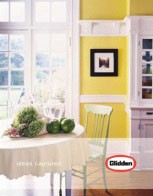

PaintA modern variation on the traditional utilizes drywall compound (spackle) as a economical substitute for plaster. Often referred to as "stucco", and used as a texturizing medium for ceilings, the techniques have recently found their way onto walls. Used to create an exotic canvas for the rich hues of African, Middle Eastern, and Mediterranean decors, the finish is durable, easy to clean, and cost effective when latex paints are mixed into the spackle prior to application. Since the spackle is applied in thin layers and dried thoroughly between layers, complementary colours can be used to build depth and character into walls.



Even in older homes
where
the variety of techniques and materials evident in walls, floors, and
ceilings pays tribute to decades of building advancements, paint can
provide unity. Long gone are the days when your only paint choice
was white. Virtually any colour including metallics and stone can be
replicated in paint using special mix formulas or techniques.
For a preview of your colour choices or to help you select from the thousands of colours, check out the website below for great colour selection tools.
The Basics of Primer, Oils, Latexes, Enamels
Primers refer to flat (no gloss) paints that are applied as a primary coat on any new or refinished surface. Since tinting paints dilutes the consistency, primers should be tinted a few shades lighter than the finish colours when using deep hues such as burgundy or royal blue. This helps to ensure more even coverage. Always use latex based primer with latex, and oil based primer with oil based paints. Oil and water don't mix.
Self Priming refers to formulations that do not require primer for new surfaces. This type is best for surfaces where old finishes cannot be completely removed.
Acrylic is an additive that boosts the hardness or scrubbability of paint.
Latex is any water based paint or varnish. It is best used in low traffic areas and ceilings.
Oil is a more durable base usually used on metal. It is also advisable for wood and drywall in areas where there is high humidity or frequent scrubbing is required.
Enamels are the most durable and the most difficult to use due to the strong odor.
Always use according to manufacturer's directions in a well ventilated area.
Glosses
In addition to picking a tint and a base, you will also be asked to choose a gloss type. Which type you choose depends on a number of factors. The inclusion of gloss in paint is similar to applying varnish over stain. The more varnish applied, the more durable the finish. The main drawback being that as more varnish enhances the grain of wood, more gloss can highlight imperfections insurfaces such as drywall.
For a preview of your colour choices or to help you select from the thousands of colours, check out the website below for great colour selection tools.
The Basics of Primer, Oils, Latexes, Enamels
Primers refer to flat (no gloss) paints that are applied as a primary coat on any new or refinished surface. Since tinting paints dilutes the consistency, primers should be tinted a few shades lighter than the finish colours when using deep hues such as burgundy or royal blue. This helps to ensure more even coverage. Always use latex based primer with latex, and oil based primer with oil based paints. Oil and water don't mix.
Self Priming refers to formulations that do not require primer for new surfaces. This type is best for surfaces where old finishes cannot be completely removed.
Acrylic is an additive that boosts the hardness or scrubbability of paint.
Latex is any water based paint or varnish. It is best used in low traffic areas and ceilings.
Oil is a more durable base usually used on metal. It is also advisable for wood and drywall in areas where there is high humidity or frequent scrubbing is required.
Enamels are the most durable and the most difficult to use due to the strong odor.
Always use according to manufacturer's directions in a well ventilated area.
Glosses
In addition to picking a tint and a base, you will also be asked to choose a gloss type. Which type you choose depends on a number of factors. The inclusion of gloss in paint is similar to applying varnish over stain. The more varnish applied, the more durable the finish. The main drawback being that as more varnish enhances the grain of wood, more gloss can highlight imperfections insurfaces such as drywall.
| Gloss Type |
Use |
Surfaces/Areas/Rooms |
Scrubbable |
| Flat no sheen |
Use
as primer only As surface prep for wallpaper or stucco Can be tinited to enhance/mask deep tinted finish coats |
All
new surfaces |
No |
| Pearl Semi Gloss Satin low to med. sheen |
Finish
coat |
All
surfaces Uneven surfaces Low traffic areas Bedrooms Ceilings |
Medium |
| HighGloss high shine |
Finish
coat |
High
traffic areas Will highlight imperfections |
Very |
| Lacquer glasslike shine |
Finish
coat |
Usually
used on wood cabinetry or metal Not suitable for surfaces with imperfections |
Very |



Varnishes
Like paints varnishes come in an array of bases and glosses. The same rule of thumb applies for bases. Use oil based varnishes for high traffic areas or where water is likely to collect. Use water based for low traffic areas and trim.
Varnish glosses differ slightly from paints in that high gloss finishes are more likely to scratch and need to be refinished more often. High gloss is not suitable for high usage or traffic areas such as floors, counter tops, or table tops. To develop a glass like shine in these areas, use semi gloss varnish. Once completely dry, build high gloss shine using 2-3 coats of good quality paste wax (available at hardware stores).
With such
a wide choice of high quality, easy to install wall coverings
available, you may never want to pick up a paint brush
again. Manufacturers have made it easier than ever to coordinate
patterns, themes, metallic accents, borders, chair rails, and tasteful
murals. Some companies even offer a selection of coordinating
fabrics.
Preparation
To add to the ease, invest in a good laser level to help keep wallpaper borders and chair rails straight.
New drywall must be primed before installing paper. Let it dry for 24 to 48 hours before papering.
For previously painted walls:
To remove existing wallpaper:
Leftover wallpaper is perfect for creating accent pieces and accessories. Dress up tired dressers, tables, and pelmets with panels of wall coverings. Create framed pictures, shutters, room dividers by stapling paper over a frame.
Glass
BlockPreparation
To add to the ease, invest in a good laser level to help keep wallpaper borders and chair rails straight.
New drywall must be primed before installing paper. Let it dry for 24 to 48 hours before papering.
For previously painted walls:
- Start by washing them down with TSP, a compound available at most hardware or paint/paper supply stores.
- Let walls dry thoroughly.
- Lightly sand walls to remove gloss finishes.
- Fill in cracks and holes with drywall compound. let dry, then sand smooth.
To remove existing wallpaper:
- Use warm water and a sponge to soak the paper.
- Loosen an edge and pull gently to remove.
- For stubborn pieces, re soak area and use a plastic putty or drywall knife to loosen.
Leftover wallpaper is perfect for creating accent pieces and accessories. Dress up tired dressers, tables, and pelmets with panels of wall coverings. Create framed pictures, shutters, room dividers by stapling paper over a frame.
A beautiful addition
to any
room, glass blocks affords privacy while allowing light to flow into
the room. It is perfect for entries, bathrooms, and room dividers.
Blocks are fitted together with preformed dividers to maintain stability, while appearing to be separated only by grout. The grout can be tinted to match any decor.
TileBlocks are fitted together with preformed dividers to maintain stability, while appearing to be separated only by grout. The grout can be tinted to match any decor.
Porcelain
Wall tiles differ slightly from that used on floors in that they are thinner and made from porcelain rather than clay. Available in a wide array of patterns and sizes, beautiful combinations are easy to create. Many companies now produce packaged combinations of tile and coordinating mosaic borders.
When choosing tile for a bath or kitchen, be aware that some tile materials are porous allowing it to absorb and hold moisture. This makes it unsuitable for food preparation surfaces as the pores can trap bacteria and make it more susceptible to staining.
Like glass block, tile grouting can be tinted to match or contrast the tile.
Fiber
Available in 12" x 12" or 24" x 18", these tile provide a low cost alternative to drywall and can be a quick cover up for uneven ceilings and peeling paint. Most tiles are available in white or off-white, but are easily painted to match your tastes.
To install fiber tile, the ceiling must be first strapped with 1/2" by 2" lumber. The tile is then attached to the lumber. Stapling the tile directly to existing drywall or plaster is inadvisable since neither material is sufficiently strong enough to hold the combined weight of a ceiling.
Suspended Ceilings
As the name suggests, fiber tiles are mounted in a light metal framework and suspended from the rafter or overhead floor joists. This feature makes suspended tile an excellent choice for basement ceilings or anywhere that wiring or heating pipes are visible. Since tiles are easily removed access to electrical, plumbing, and heating systems is maximized.
Lighting these areas is easier too since tile can be swapped out for textured plexiglass panels that allow fixtures mounted above ceiling level to shine through.
Fiber tiles and the metal tracking used to suspend it can be painted prior to installation.
Wall tiles differ slightly from that used on floors in that they are thinner and made from porcelain rather than clay. Available in a wide array of patterns and sizes, beautiful combinations are easy to create. Many companies now produce packaged combinations of tile and coordinating mosaic borders.
When choosing tile for a bath or kitchen, be aware that some tile materials are porous allowing it to absorb and hold moisture. This makes it unsuitable for food preparation surfaces as the pores can trap bacteria and make it more susceptible to staining.
Like glass block, tile grouting can be tinted to match or contrast the tile.
Fiber
Available in 12" x 12" or 24" x 18", these tile provide a low cost alternative to drywall and can be a quick cover up for uneven ceilings and peeling paint. Most tiles are available in white or off-white, but are easily painted to match your tastes.
To install fiber tile, the ceiling must be first strapped with 1/2" by 2" lumber. The tile is then attached to the lumber. Stapling the tile directly to existing drywall or plaster is inadvisable since neither material is sufficiently strong enough to hold the combined weight of a ceiling.
Suspended Ceilings
As the name suggests, fiber tiles are mounted in a light metal framework and suspended from the rafter or overhead floor joists. This feature makes suspended tile an excellent choice for basement ceilings or anywhere that wiring or heating pipes are visible. Since tiles are easily removed access to electrical, plumbing, and heating systems is maximized.
Lighting these areas is easier too since tile can be swapped out for textured plexiglass panels that allow fixtures mounted above ceiling level to shine through.
Fiber tiles and the metal tracking used to suspend it can be painted prior to installation.
Metal Tile
One of the most
beautiful
and durable of historical ceiling and wall applications is making a
comeback. Made of lightweight aluminum, these patterned tiles
allow a choice of soft metallic finishes or a primed surface ready for
your choice of paint colours.
Turn of the century homes and commercial building featuring ceilings finished in metal tile are plentiful in Renfrew County. Sweet's Decor, located on Raglan Street in Renfrew, is an excellent location to view a beautifully preserved example. Painted in a soft teal, the embossed tile pattern and generous crown moldings are highlighted by underhung lighting.
Metal tile is best suited to cathedral ceilings. For best results with a standard height ceiling, choose open patterns with a minimum of embossing. As a wall or ceiling treatment, metal tiles provide a nearly indestructible surface for young families.
Turn of the century homes and commercial building featuring ceilings finished in metal tile are plentiful in Renfrew County. Sweet's Decor, located on Raglan Street in Renfrew, is an excellent location to view a beautifully preserved example. Painted in a soft teal, the embossed tile pattern and generous crown moldings are highlighted by underhung lighting.
Metal tile is best suited to cathedral ceilings. For best results with a standard height ceiling, choose open patterns with a minimum of embossing. As a wall or ceiling treatment, metal tiles provide a nearly indestructible surface for young families.
Flooring
| Choices for Rooms |
Smooth Transitions |
| Painted Floors | Basement Floors |
- amount and type of traffic
- moisture
- environment/lifestyle
Traffic is a
particularly
important consideration since the higher the traffic, the more wear
will occur in the flooring. Using flooring that is easily
maintained and that can be refinished or replaced in sections can
reduce the costs and protect your investment for many years.
The second factor is moisture. Ceramic tiles and linoleum tend to wear best while suffering the least damage in areas where moisture from outside or interior water sources are likely to find their way to the floor.
While all flooring types require daily sweeping or vacuuming, lifestyle is a factor to be considered when making a flooring choice. Hard surfaces like hardwood, laminates, linoleum and tile tend to contribute less to airborne allergens. These also tend to be the best choice for those leading busy lifestyles or that include children and pets. For those that want to enjoy the luxury and warmth a carpet lends to a room, area rugs make an excellent alternative.
The outdoor environment also plays a role in determining flooring since entry areas are the most vulnerable to damage from snow, rain, salt and sand. Asphalt driveways impart a residue and can discolour linoleums and some rugs.
The second factor is moisture. Ceramic tiles and linoleum tend to wear best while suffering the least damage in areas where moisture from outside or interior water sources are likely to find their way to the floor.
While all flooring types require daily sweeping or vacuuming, lifestyle is a factor to be considered when making a flooring choice. Hard surfaces like hardwood, laminates, linoleum and tile tend to contribute less to airborne allergens. These also tend to be the best choice for those leading busy lifestyles or that include children and pets. For those that want to enjoy the luxury and warmth a carpet lends to a room, area rugs make an excellent alternative.
The outdoor environment also plays a role in determining flooring since entry areas are the most vulnerable to damage from snow, rain, salt and sand. Asphalt driveways impart a residue and can discolour linoleums and some rugs.
| Room |
Recommended
Flooring |
Traffic
Rating |
Special
Considerations |
| Entry Kitchen Bath |
Tile Linoleum |
High |
moisture
resistant non-slip surfaces durable, non-scratch surfaces |
| Living
Room |
Hardwood Carpet Laminate |
Medium |
easy
to clean |
| Bedrooms Dining Rooms |
Carpet Hardwood* Laminates* |
Low |
easy
to clean *allergen reducing |
| Halls |
All |
Medium High |
easy
to clean durable, non-scratch surfaces |
| Basement |
Hardwood Tile PVC Interlock Tile Paint |
Medium High |
Moisture
resistant Framing combined with a moisture/heat barrier is required |
Smooth transitions
Since a difference
in
height as small as of 1/8" can lead to falls, it is important to make
flooring choices as early as the design stage.
Your builder should be aware of flooring choices because it will affect framing particularly where interior components such as windows, doors, cabinetry, and stairs are involved. Underlays such as mahogany and plywood are used to ensure that the floor height remains constant regardless of the material used. Changing or adding underlay late in the framing or finishing stage of building may mean that doors, stairs, cabinets, and trim will need to be reset or trimmed.
Painted
FloorsYour builder should be aware of flooring choices because it will affect framing particularly where interior components such as windows, doors, cabinetry, and stairs are involved. Underlays such as mahogany and plywood are used to ensure that the floor height remains constant regardless of the material used. Changing or adding underlay late in the framing or finishing stage of building may mean that doors, stairs, cabinets, and trim will need to be reset or trimmed.
Painting is a
temporary and affordable alternative to replacing existing flooring or
installing new and a great way to use up left over primer and
paint. Simulated granite flooring or tile, introduce borders,
ragging, and marbleizing are just a few of the techniques that look
great and are easy to do. There are also a number of different
flooring paints such as the new two step process that lets you create
tile, stone, and other textures in the surface prior to applying the
paint. When using these products, always follow manufacturer's
directions.
For wood floors, plywood, and underlay:
Note: Composite board and aspenite are not good choices for painting.
For wood floors, plywood, and underlay:
Note: Composite board and aspenite are not good choices for painting.
- Clean the surface with TSP.
- Remove nails and fill with wood filler.
- Use a palm sander to lightly sand to remove finishes or imperfections.
- Seal mahogany underlay with white shellac before priming to prevent bleed through.
- Prime floor using flat primer.
- Apply paint in desired technique. Any good quality paint can be used since the floor must be finished with varnish to prevent scrapes. Concrete floors require paints specially formulated for concrete.
- Finish with three coats of semi gloss varnish. Choose water based or oil depending on the paint used.
- For higher gloss, apply 1-3 coats of paste wax and buff to shine.
Basement
Floors
Built-in Units
Subterranean and
unheated
floors present challenges of their own due to concrete's ability to
retain heat. Unfortunately, unless you have radiant heating in your
basement, the heat your concrete floor is retaining will be from the
ground encasing the concrete. The reason basements always feel
cooler than upper levels during the summer months is due to the fact
that ground heat remains at a constant 52 degrees
Fahrenheit. This temperature is below normal room temperature and
may feel uncomfortably cool in winter months.
To help ensure basement and other concrete floors feel warm and comfortable, some steps must be taken to separate the concrete and the flooring material. One solution is to lay down an insulating membrane and and finish with flooring choice. The second solution involves building a framework and insulating the openings, then laying a plywood sub floor to provide a solid surface for flooring. Aspenite is not a suitable floor sheathing where moisture levels are elevated.
To help ensure basement and other concrete floors feel warm and comfortable, some steps must be taken to separate the concrete and the flooring material. One solution is to lay down an insulating membrane and and finish with flooring choice. The second solution involves building a framework and insulating the openings, then laying a plywood sub floor to provide a solid surface for flooring. Aspenite is not a suitable floor sheathing where moisture levels are elevated.
Built-in Units
Make the most of
awkward
nooks or shared walls with built in cabinetry. A china cabinet
for the dining room, book cases or entertainment unit for the living
room, a chest of drawers inside a closet, and extra storage in the bath
and kitchen are a few suggestions to gain valuable space and make
it work for you.
